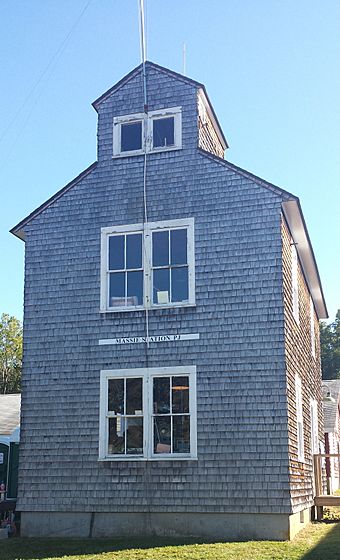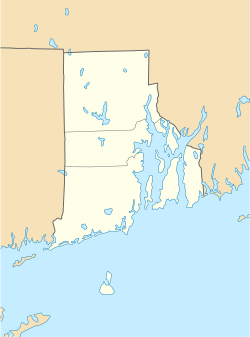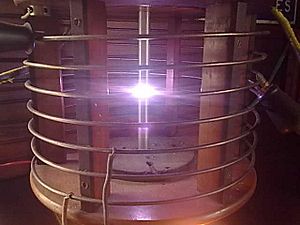Massie Wireless Station facts for kids
Quick facts for kids |
|
|
Massie Wireless Station
|
|

The station at its current location
|
|
| Location | 1300 Frenchtown Road East Greenwich, Rhode Island |
|---|---|
| Built | 1907 |
| NRHP reference No. | 01001157 |
| Added to NRHP | October 22, 2001 |
The Massie Wireless Station is a very old building in Point Judith, Rhode Island. It was built in 1907 and might be the oldest working wireless (radio) station still around today! It's named after Walter Wentworth Massie, who invented things and ran the Massie Wireless Telegraph Company. In 1983, the building was moved to the New England Wireless and Steam Museum. There, it is kept safe as a technology museum and a historic site for everyone to learn from.
Contents
History of the Wireless Station
In December 1902, a company called American De Forest Wireless Telegraph Company set up an early radio station. It was in an old house on a beach near Point Judith Light. They also set up another station near Block Island Southeast Light, about 15 miles (24 km) away. By May 1903, they had successfully sent test messages between the two places. These messages were sent using Morse code, which is a system of dots and dashes.
At first, these stations helped the Providence Journal newspaper. They sent news stories to Block Island so the paper could be printed there. Another goal was for ships passing by to send messages to the mainland. These messages would then be sent to Providence or New York City by phone. This meant the news would arrive hours before the ships even reached port! At that time, many ships passed by Block Island.
A newspaper called Block Island Wireless started publishing in July 1903. It was one of only two daily newspapers that printed news sent by wireless radio. Soon, the stations also started sending messages for people, called "aerograms," and charged money for this service. However, this early wireless service didn't always work well. The Block Island Wireless newspaper stopped publishing at the end of August 1903.
The newspaper was not happy with how the stations were working. So, they offered the job of managing the two stations to the new Massie company. By 1904, Massie had put in new equipment to replace the old system. This new equipment made it possible for the island and the mainland to send messages back and forth reliably.
The stations also helped passenger steamships communicate, especially those from the Fall River Line. When Massie put wireless equipment on the steamship Plymouth, it was the first ship on Long Island Sound to have this ability. A Massie employee worked on the ship as the wireless operator. During early tests, the shore station could talk to the ship from 33 miles (53 km) away.
Sailors on these ships thought Point Judith was a dangerous spot on their route. The shore station could tell them about bad weather, like fog, hours before they reached it. The station would then help them navigate as they passed by. By 1905, the Block Island station was improved. It could pick up signals from large ocean liners even beyond the Nantucket Shoals Lightship 66, which was 150 miles (240 km) away.
In 1907, Walter Massie built a new, better building for the Point Judith station. This is the same building that is saved today. The radio transmitter inside used a "spark-gap" system and could send out up to 2,000 watts of power. It was connected to a very tall antenna tower, which was 300 feet (91 m) high. The radio waves it sent out were about 400 metres (750 kHz) long in 1907 and 325 metres (920 kHz) long in 1912.
In May 1910, two steamships, the Santurce and Ligonaire, crashed off the coast of Cape Cod because of thick fog. The Point Judith station received their distress call (a message asking for help, called CQD). The station then sent a special tugboat to help the ships. In April 1912, wireless operators at the station listened carefully for news from rescue ships about the terrible sinking of the RMS Titanic.
In August 1912, Massie sold his stations to Marconi's Wireless Telegraph Company. This sale included all the shore stations and ship stations, along with their business agreements. Massie kept the rights to his inventions and continued to work in his laboratory. The Point Judith station stopped working shortly after this sale. When it closed, it could send messages up to 500 miles (800 km) away.
In 1917, a "radiophone fog warning device" was put in the lighthouse next to the closed Massie station. It sent out a voice recording that said "Point Judith Light" using wireless radio. Ships could hear this message up to 8 miles (13 km) away. After saying it three times, it would then say "you are getting closer; keep off" at a lower power. This message could only be heard within 2 miles (3.2 km) miles.
After that, the building became a Western Union landline telegraph station until World War II. In the years that followed, it was used as a summer house.
Other Stations in the Massie Network
The two first stations were joined by others to create a system along the southern coast of New England. Massie also ran other stations from New Jersey to Massachusetts. The Point Judith station was known by its special call letters "PJ". Here are some other stations that were part of the Massie system:
| Location | Call Letters |
|---|---|
| Chatham, Massachusetts | AU |
| Block Island, Rhode Island | BI |
| Cape May, New Jersey | CP |
| Providence, Rhode Island | HG |
| Jacksonville, Florida | JX |
| Point Judith, Rhode Island | PJ |
| Wilson's Point at Norwalk, Connecticut | WN |
| New London, Connecticut | WS |
The Massie system also had wireless equipment on many steamships, especially those from the Fall River Line. This allowed the ships to communicate with the shore stations.
| Steamship | Call Letters |
|---|---|
| Priscilla | CA |
| Pilgrim | GM |
| Chester W. Chapin | HN |
| Providence | PV |
| Plymouth | PX |
| Puritan | RN |
| City of Lowell | WE |
Saving the Station
In 1983, the Massie Wireless Station building was moved to the New England Wireless and Steam Museum in East Greenwich, Rhode Island. This was done to save it from being torn down. The place where it used to be is now part of Roger Wheeler State Beach. The station is now located within the Tillinghast Road Historic District.
The original equipment from the station was given to the Museum by Massie's family. The transmitter still works and now operates at 850 metres (350 kHz), though it is not connected to an antenna. The station was added to the National Register of Historic Places in 2001. This means it is recognized as an important historical place.
A group called the Massie Wireless Club started using the station for amateur radio (ham radio) in 2018. They use the club call sign N1EPJ. Another building at the museum has a collection of many old telegraph, radio, and television machines.
See also
- Archie Frederick Collins – Massie's company joined with Collin's company in 1909, but this arrangement did not last long.
Images for kids







